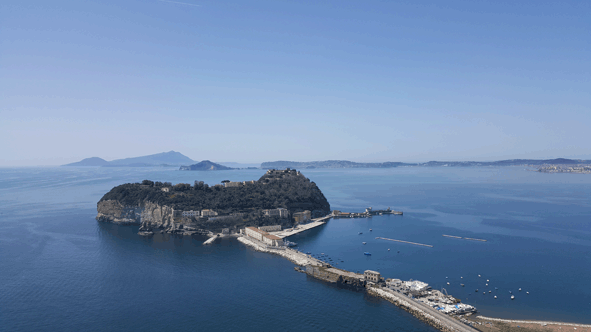Paesaggi naturali ed antropici nei Campi Flegrei: relazioni tra identità e potenzialità per lo sviluppo sostenibile
Abstract
Questo contributo si propone di evidenziare le relazioni peculiari tra fattori naturali e antropici che hanno modificato il paesaggio dei Campi Flegrei a partire dai primi insediamenti greci e romani fino all’epoca attuale. Il dinamismo di questo paesaggio è dovuto principalmente al vulcanesimo, di cui il bradisismo è il più noto fenomeno ivi manifestatosi. Inoltre, il mare e, più in generale, l’acqua hanno avuto un ruolo notevole nel plasmare tale territorio. L’identità mediterranea caratterizza fortemente questa zona costiera, che nel tempo ha attirato nobili, artisti, scienziati e turisti.La ricerca si concentra su tre comuni: Pozzuoli, Bacoli e Monte di Procida. Le loro analisi mostrano molte similitudini in termini ambientali, culturali, paesaggistici e urbani. Infine, una panoramica dei punti di forza e di debolezza dell’area di studio fornisce la base per il disegno di un’infrastruttura verde-blu flegrea intesa come mezzo per riconnettere il patrimonio culturale con il paesaggio e per incentivare il suo sviluppo sostenibile.
Downloads
Riferimenti bibliografici
Agnoletti, M. (2014), ed. by, Paesaggi rurali storici/Historical rural landscapes, Touring Ed. , Milano
Arata F. P. (2014), La navigabilis fossa di Nerone, in Mélanges de l’École française de Rome – Antiquité, 126 (2014), 1
Austin G. (2014), Green Infrastructure for Landscape Planning: Integrating Human and Natural Systems, Routledge, London
AA.VV. (2000), Il Paesaggio Italiano, Touring Ed. , Milano
Barberi F., Cassano E., La Torre P. and A. Sbrana (1991), Structural evolution of Campi Flegrei caldera in light of volcanological and geophysical data, Journal of Volcanology and Geothermal Research, 48, 1–2/August 1991, pp. 33-49
Cardone V. and L. Papa (1993), L’identità dei Campi Flegrei, Cuen, Napoli
Dinetti M. (2000), Infrastrutture ecologiche, Il Verde Editoriale, Milano
Forte F. (2003), ed. by, Il ruolo delle aree metropolitane costiere nel Mediterraneo, edited by Francesco Forte, Alinea, Firenze
Forte F. (2006), Politiche urbane, Napoli: storie, bisogni, opportunità, INU Edizioni, Roma
Fraticelli V., Mariniello A. F., Picone L., Piemontese A. and Scarano R. (2009), Bacoli e Monte di Procida, edited by Luigi Picone, Massa Editore, Napoli
Landini P. (2006), Atlante Geografico Italia, Touring Ed. , Milano
Marcarini A. (2014), “La Piscina Mirabilis” in Tesoro Italia. Il patrimonio negato, edited by Anna Ferrari-Bravo, Touring Ed. , Milano, pp.204-207
Miano P., Izzo F. and L. Pagano (2017), ed. by, I Campi Flegrei. L’architettura per i paesaggi archeologici, Quodlibet, Macerata
Motti R., Maisto A., Migliozzi A. and S. Mazzoleni (2004), Le trasformazioni agrarie del paesaggio agricolo e forestale dei Campi Flegrei nel XX secolo, Informatore Botanico Italiano, 36 (2), pp.577-583
Moccia F. and B. Scalera (2017), “UIA and the MAC project: green city and multi-ethical connections for Monteruscello neighbourhood. Pozzuoli case study”, Tria, 18, 01/2017, Naples, pp.173-186
Musi A. (2010), Regno di Napoli, Omnia Arte, Napoli
Norberg-Schulz C. (1979), Genius Loci, Electa, Milano
Paget R.F. (1968), The ancient Ports of Cumae, The Journal of Roman Studies, 58, Parts 1-2, pp.152-169
Picone L. (2009), La costa sul Golfo di Napoli-The coast of the Bay of Naples, Massa Editore, Napoli
Piscopo C. and P. Scala (2012), Building the landscapes of Monte di Procida, IJPP - Italian Journal of Planning Practice, Vol. II, issue 1 – 2012, pp.71-92
Sereni E. (1961), Storia del paesaggio agrario italiano, Laterza, Bari
Sirpettino M. (1999), I Campi Flegrei. Guida storica, Edizioni Scientifiche Italiane, Napoli

Copyright (c) 2018 Paolo Camilletti, Gianluca Lanzi

This work is licensed under a Creative Commons Attribution 4.0 International License.
Gli autori che pubblicano su questa rivista accettano le seguenti condizioni:- Gli autori mantengono i diritti sulla loro opera e cedono alla rivista il diritto di prima pubblicazione dell'opera, contemporaneamente licenziata sotto una Licenza Creative Commons - Attribuzione che permette ad altri di condividere l'opera indicando la paternità intellettuale e la prima pubblicazione su questa rivista.
- Gli autori possono aderire ad altri accordi di licenza non esclusiva per la distribuzione della versione dell'opera pubblicata (es. depositarla in un archivio istituzionale o pubblicarla in una monografia), a patto di indicare che la prima pubblicazione è avvenuta su questa rivista.
- Gli autori possono diffondere la loro opera online (es. in repository istituzionali o nel loro sito web) prima e durante il processo di submission, poiché può portare a scambi produttivi e aumentare le citazioni dell'opera pubblicata (Vedi The Effect of Open Access).
